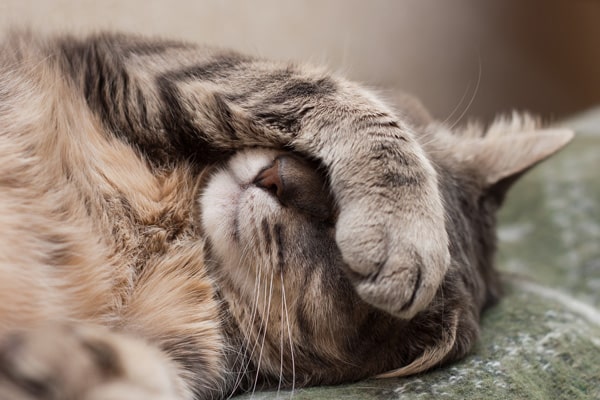The post Have a Sick Cat? 9 Ways to Tell if Your Cat Is In Pain by JaneA Kelley appeared first on Catster. Copying over entire articles infringes on copyright laws. You may not be aware of it, but all of these articles were assigned, contracted and paid for, so they aren't considered public domain. However, we appreciate that you like the article and would love it if you continued sharing just the first paragraph of an article, then linking out to the rest of the piece on Catster.com.
Some of the most profoundly heartbreaking moments of my cat-caretaking life revolve around being unable to tell how much pain my beloved friends were suffering. Even though I know cats are very good at disguising their pain, I can’t help but guilt-trip myself sometimes over this health issue, because as a person who’s lived with cats almost all my life, I “should” be able to notice when something’s out of whack. A sick cat will show “symptoms,” although often they’re quite subtle. In hopes of helping you recognize signs of pain that eluded me, here are some tips that could signal a sick cat or a cat in pain.

How do you tell if your cat is in pain? Photography by Katerina Maksymenko | Shutterstock.
1. A sick cat may exhibit changes in behavior
If a super-active cat starts spending most of her day sleeping, this could be a sign that you have a sick cat. Likewise, if a cat becomes grumpy, it’s not because she’s “just getting old.” I learned this the hard way when, after Siouxsie had four painful teeth extracted, her whole disposition changed. Normally sedate cats can become really hyper and agitated as a result of pain, too.
2. Resistance to touch and wanting to be left alone may signal an issue
If your cat begins growling, swatting or snapping when stroked, touched or moved, that’s a sign something is bothering him.
Suffering from chronic pain yourself? Here’s how to get relief >>
3. A sick cat might stick to one sleeping position
When Siouxsie’s hips are bothering her, she only sleeps on her right side. Her left hip is more arthritic than the right one, and I suspect it’s more comfortable for her to sleep on the right side for this reason.
4. A cat in pain might hide
Because cats know that pain makes them vulnerable, a sick cat will hide so that he can avoid being preyed upon by stronger animals.
5. Excessive licking of an area might be a sign that something is wrong
Cats who are hurting will try to bring relief by licking the area that’s bothering them. You see this a lot in cats with urinary tract infections or idiopathic cystitis. Siouxsie’s sister, Sinéad, had recurring episodes of cystitis (she was very sensitive to stress) and when her bladder was hurting, she licked her stomach bald.
6. A sick cat may stop grooming
It’s not normal for older cats to get greasy and scruffy. Most older cats look less “put together” than they did in their younger years because arthritis or other conditions have made the stretching required for grooming too painful. Any cat who stops grooming needs to be seen by a veterinarian.
7. Abnormal body positions could mean trouble
A cat in severe pain will sit hunched up with her feet tucked under her and her nose almost on the floor. But there are other abnormal positions that may not be so obvious. For example, in the first video I shared in my post about medical cannabis, Siouxsie was walking in short strides with a hunched gait.
8. A cat in pain may get a faraway look in the eyes
This is particularly telling if it’s combined with abnormal body positions. I saw this look in Dahlia’s eyes a lot toward the end of her life.
9. A sick cat might exhibit changes in litter box habits
Cats with painful backs and hips may have trouble using the litter box as well as they used to. Holding the appropriate positions for peeing and pooping can be very difficult for a sick cat with sore hips or knees. Kissy peed up the side of the box and got urine on the floor and walls, for example, because her bad knee made it too painful for her to maintain the usual “pee squat.”
Tell us: Are there other subtle cat pain signs that you’ve noticed? Please share them in the comments.
Still not sure if your cat is in pain? Even more signs to look out for >>
Thumbnail: Photography by Nikolay Bassov | Shutterstock.
This piece was originally published in 2015.
Read Next: Cat Acne: Yes, It Exists and Yes, You Can Treat It
The post Have a Sick Cat? 9 Ways to Tell if Your Cat Is In Pain by JaneA Kelley appeared first on Catster. Copying over entire articles infringes on copyright laws. You may not be aware of it, but all of these articles were assigned, contracted and paid for, so they aren't considered public domain. However, we appreciate that you like the article and would love it if you continued sharing just the first paragraph of an article, then linking out to the rest of the piece on Catster.com.
JaneA Kelley